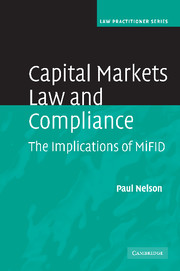Book contents
- Frontmatter
- Contents
- Preface
- List of acronyms
- Part I Evolution of capital markets regulation, FSA and the European single market
- Part II Licensing and rule application
- Part III The firm's infrastructure
- Part IV Conduct of business
- 8 Client classification and client documentation
- 9 Principles of conduct
- 10 Marketing investments
- 11 Advising clients
- 12 Improper behaviour in dealing and executing orders
- 13 Dealing and executing orders
- 14 Exchanges and MTFs
- Part V Application of rules to particular businesses
- Bibliography
- Index
13 - Dealing and executing orders
Published online by Cambridge University Press: 03 December 2009
- Frontmatter
- Contents
- Preface
- List of acronyms
- Part I Evolution of capital markets regulation, FSA and the European single market
- Part II Licensing and rule application
- Part III The firm's infrastructure
- Part IV Conduct of business
- 8 Client classification and client documentation
- 9 Principles of conduct
- 10 Marketing investments
- 11 Advising clients
- 12 Improper behaviour in dealing and executing orders
- 13 Dealing and executing orders
- 14 Exchanges and MTFs
- Part V Application of rules to particular businesses
- Bibliography
- Index
Summary
Transactions
Much of banking, investment banking, broking and dealing is a process and to that extent regulatory compliance, which is derivative of commercial operations in that it regulates a commercial activity, is itself a process. The way the firm executes transactions, both for itself and clients, is a paradigm example of this; and so, as with all law and regulation, that of transaction execution is best understood by placing it in the context of the commercial activity.
Pre-transaction
The firm may have actively promoted the product or service to the client (10), but will have in any event gone through the client categorisation and take-on process (8.1–8.4) which may have resulted in the giving of advice or exercise of discretion on the client's behalf (11.1, 11.2) unless it was an execution-only client (11.3, 11.4). Alternatively, there may be no client involvement whatsoever, it being a proprietary transaction solely for the firm's own account.
The order to deal
Pre-MiFID: The firm, obviously, should only ‘undertake transactions …having received authority to do so from the … customer’, the client's order having been communicated to the firm or a discretionary decision to deal taken by the firm, in either case resulting in the need for the firm to have created, and kept for three years, a detailed record of ‘(a) the customername … (b) the date and time … (c) the … employee who received the … order or made the decision … (d) … the … investments …
- Type
- Chapter
- Information
- Capital Markets Law and ComplianceThe Implications of MiFID, pp. 378 - 417Publisher: Cambridge University PressPrint publication year: 2008



